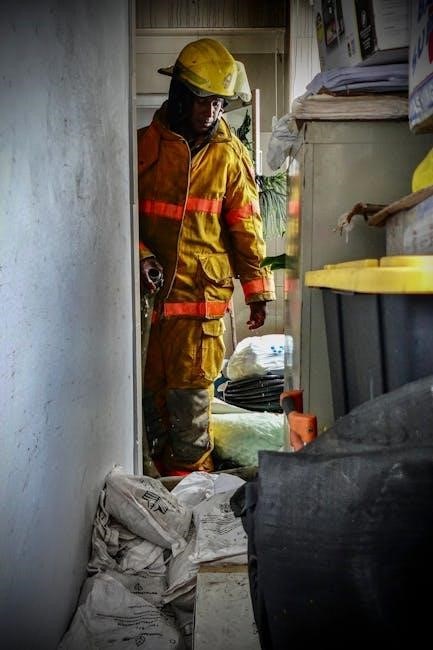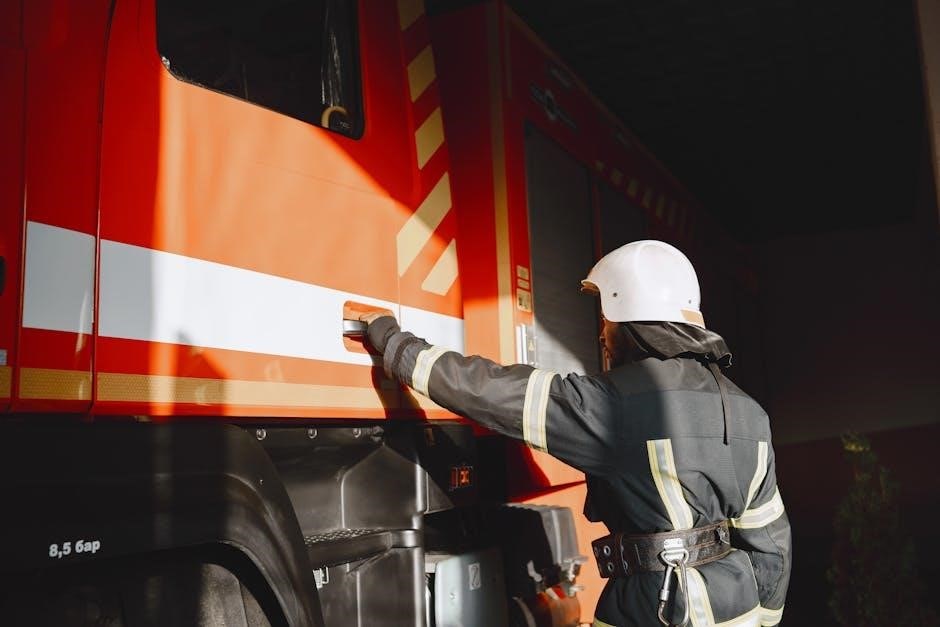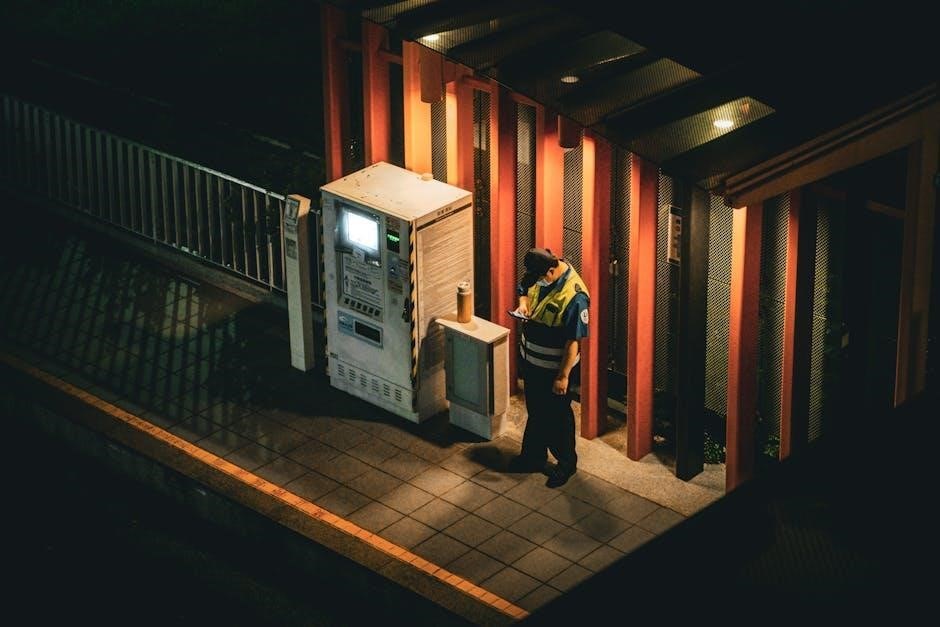Welcome to the First Alert manual guide, your essential resource for understanding and operating First Alert smoke and carbon monoxide alarms. These manuals provide critical information to ensure safety and proper device functionality.
Overview of First Alert Smoke and Carbon Monoxide Alarms
First Alert smoke and carbon monoxide alarms are designed to provide early warnings for fires and CO leaks, ensuring home safety. These alarms use advanced technologies like photoelectric and ionization sensors to detect threats. They meet regulatory standards, including UL 217 and 2034, for reliable protection. Available in various models, they offer features like combination detection for smoke and CO, voice alerts, and smart connectivity. Built to last, First Alert alarms are user-friendly and designed to keep you and your family safe with minimal false alarms and clear notifications.
Importance of Reading the Manual
Reading the First Alert manual is crucial for understanding your smoke and carbon monoxide alarm’s features, ensuring proper installation, and maintaining functionality. The manual provides detailed instructions on how to operate the device, troubleshoot issues, and perform routine maintenance. It also outlines essential safety information, such as recognizing false alarms and understanding alarm signals. By following the guidelines, you can ensure compliance with safety standards like UL 217 and 2034. The manual also explains how to maximize the device’s early warning capabilities, which are critical for protecting your home and family. Familiarizing yourself with the manual ensures optimal performance and peace of mind.

Installation and Setup
Proper installation is crucial for optimal performance. Follow the step-by-step guide in the manual to ensure correct placement and setup of your First Alert smoke or CO alarm.
Choosing the Right Model for Your Needs
Selecting the appropriate First Alert smoke and carbon monoxide alarm model is crucial for ensuring optimal safety. Consider the size of your space, the type of hazards you want to detect, and the specific features you need, such as photoelectric or ionization sensors. Models vary in sensitivity and additional features like voice alerts or smart connectivity. Review product descriptions and certifications, such as UL 217 and 2034 standards, to ensure compliance with safety regulations. Reading user reviews and understanding warranty terms can also aid in making an informed decision tailored to your home or business requirements.
Step-by-Step Installation Guide
Installing your First Alert smoke or carbon monoxide alarm is straightforward. Begin by selecting a location on the ceiling or wall, ensuring compliance with local regulations. Use the provided mounting bracket and screws to secure the base. Drill holes if necessary, then attach the bracket firmly. Insert the alarm into the base until it clicks. Install the battery, ensuring proper orientation. Test the alarm by pressing the test button until it sounds. Finally, label the alarm with its location and date of installation. Regularly check the alarm’s functionality to ensure your safety and compliance with fire codes.

Features of First Alert Smoke Alarms
First Alert smoke alarms offer advanced features like early warning systems, photoelectric and ionization technology, UL certification, and tamper-resistant designs to ensure reliable fire detection and safety.
Early Warning Systems and Sensitivity
First Alert smoke and carbon monoxide alarms are designed to provide early warning systems with high sensitivity. These alarms detect particles in the air, triggering alerts before hazardous conditions escalate. Advanced sensors ensure early detection of smoke and CO levels, offering critical seconds for evacuation. The sensitivity is calibrated to minimize false alarms while maintaining reliable performance. By meeting standards like UL 217, these devices ensure accurate detection, providing peace of mind for homeowners. Proper installation and maintenance are key to maintaining optimal sensitivity and ensuring early warnings in emergency situations. Regular testing is recommended to verify sensor functionality.
Photoelectric and Ionization Technology
First Alert smoke alarms utilize two advanced technologies: photoelectric and ionization; Photoelectric alarms detect smoke using a light beam, ideal for smoldering fires, and reduce false alarms from cooking or steam. Ionization alarms are sensitive to fast-flaming fires, detecting tiny particles in the air. Both technologies ensure reliable detection of different fire types. Understanding these differences helps users choose the right model for their home; Proper installation and maintenance, as outlined in the manual, ensure optimal performance. These technologies are designed to provide early warnings, enhancing home safety and peace of mind for users. Always follow the manual’s guidelines for installation and maintenance.

Troubleshooting and Maintenance
Troubleshooting involves addressing false alarms, faulty batteries, and sensor malfunctions. Regular maintenance includes cleaning the detector, checking batteries, and testing devices to ensure proper functionality.
Common Causes of False Alarms
False alarms on First Alert smoke and carbon monoxide detectors often occur due to abnormal air conditions. Steam from showers, cooking fumes, or high humidity can trigger the sensor. Dust particles or insects entering the device may also cause unintended alerts. Additionally, nearby cleaning chemicals or paint fumes can activate the alarm. To minimize false alarms, ensure proper installation away from kitchens and bathrooms. Regularly cleaning the detector and replacing batteries when needed can also help maintain accurate functionality. Understanding these common causes can help you avoid unnecessary disruptions while ensuring your safety remains a priority. Always follow the manual’s guidance for optimal performance.
Regular Maintenance Tips
Regular maintenance is crucial to ensure your First Alert smoke and carbon monoxide alarms function properly. Clean the alarm regularly by vacuuming or using a soft brush to remove dust and debris. Test the alarm monthly by pressing the test button to verify it works. Replace batteries annually or as indicated by the low-battery warning. For hardwired models, check the wiring and connections. Never disable or remove batteries to avoid false alarms. Replace the entire unit every 10 years, as sensors degrade over time. Proper care ensures your safety and compliance with fire safety standards.

Understanding Fire and Carbon Monoxide Safety
First Alert manuals emphasize early detection of fires and carbon monoxide, adhering to safety standards like UL 217 and UL 2034. Both smoke and CO alarms are essential for comprehensive protection, as they cannot detect each other’s threats, ensuring your home is equipped to handle different emergencies effectively always.
Fire Safety Tips and Best Practices
Ensure smoke alarms are installed on every level of your home and inside sleeping areas for optimal protection. Test alarms monthly and replace batteries annually or as indicated in your First Alert manual. Keep alarms clean by vacuuming to avoid false triggers. Develop a fire escape plan and practice it with all household members. Never disable alarms during cooking, as this can lead to life-threatening situations. Store flammable materials safely and maintain a safe distance from heat sources. Regularly inspect electrical cords and appliances to prevent fires. Stay informed about local fire safety regulations and update your safety measures accordingly.
Carbon Monoxide Awareness and Precautions
Carbon monoxide (CO) is a odorless, colorless gas that can be deadly in high concentrations. First Alert alarms are designed to detect CO levels, providing early warnings to protect your family. Common sources of CO include faulty heating systems, generators, and idling vehicles in enclosed spaces. Never ignore a CO alarm; evacuate immediately and contact emergency services. Ensure proper ventilation in your home and avoid running engines indoors. Regularly test your alarm and replace batteries as needed to maintain reliability. Stay informed about CO risks and take precautions to prevent exposure for a safer living environment.

Warranty and Customer Support
First Alert products come with a comprehensive warranty. For assistance, contact Customer Support at (800) 323-9005 or visit www.firstalert.com for detailed warranty terms and support resources.
Understanding the Warranty Terms

First Alert products are backed by a comprehensive warranty ensuring reliability and customer satisfaction. Most smoke and carbon monoxide alarms come with a 5-year limited warranty, covering defects in materials and workmanship. The warranty period begins from the date of purchase, provided the product is installed and maintained according to the manual’s instructions. Registration may be required to activate warranty benefits. Exclusions apply for damage caused by misuse, tampering, or normal wear and tear. For detailed terms, refer to the warranty section in your First Alert manual or contact customer support for clarification.
How to Contact First Alert Customer Service
For assistance with your First Alert smoke and carbon monoxide alarms, contact their customer service at (800) 323-9005. Visit their official website at www.firstalert.com or www.brkelectronics.com for support. You can also request a manual or troubleshooting guide online. Their team is available to address concerns, provide maintenance tips, and guide you through warranty-related inquiries. Ensure your safety by reaching out for professional assistance whenever needed.
